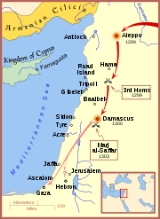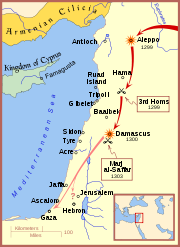
Battle of Marj al-Saffar
Encyclopedia

Mamluk
A Mamluk was a soldier of slave origin, who were predominantly Cumans/Kipchaks The "mamluk phenomenon", as David Ayalon dubbed the creation of the specific warrior...
s and the Mongols
Mongols
Mongols ) are a Central-East Asian ethnic group that lives mainly in the countries of Mongolia, China, and Russia. In China, ethnic Mongols can be found mainly in the central north region of China such as Inner Mongolia...
near Kiswe, Syria
Kiswe, Syria
Kiswe is a small city in Syria, located approximately south of Damascus. It was the location of the 1303 Battle of Marj al-Saffar, and the childhood home of Adnan Awad.-Links:* *...
, just south of Damascus. The battle, a disastrous defeat for the Mongols, put an end to Ghazan Khan's invasions of Syria.
Previous Mongol-Muslim conflict
A string of Mongol victories, starting in 1218 when they invaded KhwarezmKhwarezm
Khwarezm, or Chorasmia, is a large oasis region on the Amu Darya river delta in western Central Asia, which borders to the north the Aral Sea, to the east the Kyzylkum desert, to the south the Karakum desert and to the west the Ustyurt Plateau...
, quickly gave the Mongols control over Persia as well as the Seljuk Sultanate of Rum of Asia Minor
Asia Minor
Asia Minor is a geographical location at the westernmost protrusion of Asia, also called Anatolia, and corresponds to the western two thirds of the Asian part of Turkey...
. Incorporated troops from submitted countries such as Cilician Armenia and the Kingdom of Georgia
Kingdom of Georgia
The Kingdom of Georgia was a medieval monarchy established in AD 978 by Bagrat III.It flourished during the 11th and 12th centuries, the so-called "golden age" of the history of Georgia. It fell to the Mongol invasions of the 13th century, but managed to re-assert sovereignty by 1327...
, in 1258, the Mongols sacked Baghdad (see Siege of Baghdad (1258)), followed in 1260 by the taking of Aleppo
Aleppo
Aleppo is the largest city in Syria and the capital of Aleppo Governorate, the most populous Syrian governorate. With an official population of 2,301,570 , expanding to over 2.5 million in the metropolitan area, it is also one of the largest cities in the Levant...
and Damascus
Damascus
Damascus , commonly known in Syria as Al Sham , and as the City of Jasmine , is the capital and the second largest city of Syria after Aleppo, both are part of the country's 14 governorates. In addition to being one of the oldest continuously inhabited cities in the world, Damascus is a major...
. Later that same year, the Mongols experienced their first major defeat at the Battle of Ain Jalut
Battle of Ain Jalut
The Battle of Ain Jalut took place on 3 September 1260 between Mamluks and the Mongols in eastern Galilee, in the Jezreel Valley, not far from Ein Harod....
, which eventually forced the Mongols out of Damascus and Aleppo and back across the Euphrates
Euphrates
The Euphrates is the longest and one of the most historically important rivers of Western Asia. Together with the Tigris, it is one of the two defining rivers of Mesopotamia...
.
Nearly 40 years later, the new Khan, Ghazan, once again invaded Syria, retaking Aleppo in 1299. Ghazan defeated Mamluk forces at the Battle of Wadi al-Khazandar (3rd Battle of Homs)
Battle of Wadi al-Khazandar
The Battle of Wadi al-Khazandar, also known as the Third Battle of Homs, was a Mongol victory over the Mamluks in 1299.-Background:In 1260, Hulagu Khan had invaded the Middle East all the way to Palestine. Before he could follow up with an invasion of Egypt, he was called back to Mongolia. He left...
that same year, and Damascus quickly surrendered to him. After sending raiding parties as far south as Gaza, Ghazan withdrew from Syria.
Events just before the battle
In 1303, Ghazan sent his general Qutlugh-shah with an army to recapture Syria. The inhabitants and rulers of Aleppo and Hama fled to Damascus to flee the Mongols. However, Baibars al-JashnakirBaibars II
Not to be confused with his more famous namesake, Baibars al-BunduqdariBaibars al-Jashnakir or Baibars II. Royal name: al-Malik al-Muzaffar Rukn al-Din Baibars al-Jashnakir al-Mansuri, ....
was in Damascus and sent a message to the Sultan of Egypt to come to fight the Mongols. The Sultan left Egypt with an army to meet the Mongols in Syria and arrived while the Mongols were attacking Hama. The Mongols reached the Damascus outskirts on April 19 to meet the Sultans army. The Mamluks led them to Shaqhab where the battle would take place.
The battle
The battle started on 2 Ramadhan 702 in the HijriIslamic calendar
The Hijri calendar , also known as the Muslim calendar or Islamic calendar , is a lunar calendar consisting of 12 lunar months in a year of 354 or 355 days. It is used to date events in many Muslim countries , and used by Muslims everywhere to determine the proper day on which to celebrate Islamic...
calendar, or April 20, 1303. Qutlugh-Shah's army was positioned next to a river. The battle started by Qatlugh-Shah's left wing attacking the Mamluk's right wing with his brigade of 10,000 soldiers; the Egyptians reportedly suffered heavy casualties. The Mamluk center wing and left wing under the command of Emir Salar and Emir Baibars al-Jashnakir then came to fight the Mongols; however, the Mongols kept pushing the right flank of the Egyptian army and many of the Muslims thought the battle would be lost. The Mamluk left flank, however, held out.
Qutlugh-Shah went to the top of a nearby hill hoping to watch the victory of his forces, and whilst he was giving orders to his army, the Egyptians surrounded the hill. This led to the Mongols suffering heavy casualties on the hill. The next morning the Mamluks deliberately opened their ranks to let the Mongols flee to the river, Wadi Arram. However, when the Mongols reached the river to drink, the Sultan attacked the Mongols, and the fighting lasted till noon. By the next day, the battle was over.
Aftermath
According to the medieval Egyptian historian Al-MaqriziAl-Maqrizi
Taqi al-Din Ahmad ibn 'Ali ibn 'Abd al-Qadir ibn Muhammad al-Maqrizi ; Arabic: , was an Egyptian historian more commonly known as al-Maqrizi or Makrizi...
, when Qutlugh-Shah reached Ghazan at Kushuf after the battle to inform him of the defeat of the Mongols, the Khan became wild with rage resulting in a hemorrhage in his nose.
Messages were sent to Egypt and Damascus to tell of the victory, and the Sultan went to Damascus. While the Sultan was in Damascus the Mamluk army kept chasing the Mongols as far as Qariyatain. When the Sultan returned to Cairo, he entered Bab al-Nasr (Victory Gate) with chained prisoners of war. Singers and dancers were called from all over Egypt to celebrate the great victory. Castles were decorated and the celebrations lasted many days.

